 True Believers: Captain Marvel — Ms. Marvel #1 (of 1) — Writer: Gerry Conway; Pencils: John Buscema; Inks: Joe Sinnott; Colors: Marie Severin
True Believers: Captain Marvel — Ms. Marvel #1 (of 1) — Writer: Gerry Conway; Pencils: John Buscema; Inks: Joe Sinnott; Colors: Marie Severin
True Believers: Captain Marvel — Spider-Man and Ms. Marvel #1 (of 1) — Writer: Chris Claremont; Pencils: John Byrne; Inks: Dave Hunt; Colors: Dave Hunt
Daredevil #1 (Legacy #613) — Writer: Chip Zdarsky; Art: Marco Checchetto; Colors: Sunny Gho
Old Man Quill #1 (of 12) — Writer: Ethan Sacks; Art: Robert Gill; Colors: Andres Mossa
 Gunhawks #1 (of 1) — Writers: David and Maria Lapham; Art: Luca Pizzari; Colors: Neeraj Menon and Rachelle Rosenberg
Gunhawks #1 (of 1) — Writers: David and Maria Lapham; Art: Luca Pizzari; Colors: Neeraj Menon and Rachelle Rosenberg
February sees Marvel’s $1 “True Believers” reprint series focusing on Carol Danvers/Captain Marvel (of course; the movie’s out in March…); up first is her first ongoing comic, Ms. Marvel #1, from 1977. It’s high-end mid-’70s Marvel house style, with art by their top artists, John Buscema and Joe Sinnott, and script by then-mainstay writer Gerry Conway; there’s no origin, but a mystery, with Carol getting a job at the Daily Bugle’s magazine department to modernize their “women’s magazines” (in the real world, Ms. had debuted just five years earlier), and having blackout episodes where she becomes the costumed, amnesiac superheroine. Considering  that the original is now going for a couple of hundred dollars, it’s a good deal for just one. So too for the not-as-rare Spider-Man and Ms. Marvel, the second part of a Super-Skrull story from Marvel Team-Up #62 (the previous issue has Spidey and the Human Torch fighting him); it’s also from 1977, but six months later, and the Chris Claremont script has a better handle on an independent woman’s character than the more-stereotypical Conway one, while the early, pre-X-Men pairing with John Byrne shows, even then, the synergy that made those two such a great storytelling team. Daredevil gets a relaunch this week; Chip Zdarsky started out on humor books like Howard the Duck, but then had a decent run on Spectacular Spider-Man, and here he shows a lot of
that the original is now going for a couple of hundred dollars, it’s a good deal for just one. So too for the not-as-rare Spider-Man and Ms. Marvel, the second part of a Super-Skrull story from Marvel Team-Up #62 (the previous issue has Spidey and the Human Torch fighting him); it’s also from 1977, but six months later, and the Chris Claremont script has a better handle on an independent woman’s character than the more-stereotypical Conway one, while the early, pre-X-Men pairing with John Byrne shows, even then, the synergy that made those two such a great storytelling team. Daredevil gets a relaunch this week; Chip Zdarsky started out on humor books like Howard the Duck, but then had a decent run on Spectacular Spider-Man, and here he shows a lot of 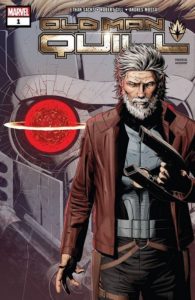 skill at standard superhero stuff, with a Hell’s Kitchen-based Matt Murdock who should be familiar to both old fans and Netflix viewers; Marco Checchetto handles the street-level noirish parts (like a pickup in a seedy bar) and the costumed-adventure ones with equal detail and flair, and there’s a compelling last-page reveal. Old Man Quill follows Old Man Logan and Old Man Hawkeye (and, over at DC, Old Lady Harley) by looking at a decades-in-the-future, defeated version of its title character, the former Star-Lord; older versions of the Guardians of the Galaxy appear, too, and there’s a tie-in to Old Man Logan, so fans of those books will want to check this out (frankly, if you aren’t already a fan, a 12-issue series by two creators you’ve probably never heard of, set in a future that won’t happen, probably won’t tempt you
skill at standard superhero stuff, with a Hell’s Kitchen-based Matt Murdock who should be familiar to both old fans and Netflix viewers; Marco Checchetto handles the street-level noirish parts (like a pickup in a seedy bar) and the costumed-adventure ones with equal detail and flair, and there’s a compelling last-page reveal. Old Man Quill follows Old Man Logan and Old Man Hawkeye (and, over at DC, Old Lady Harley) by looking at a decades-in-the-future, defeated version of its title character, the former Star-Lord; older versions of the Guardians of the Galaxy appear, too, and there’s a tie-in to Old Man Logan, so fans of those books will want to check this out (frankly, if you aren’t already a fan, a 12-issue series by two creators you’ve probably never heard of, set in a future that won’t happen, probably won’t tempt you 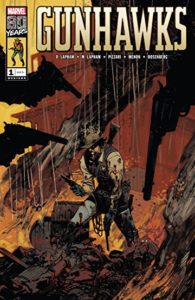 very much…). Gunhawks is another in a series of Marvel 80th-anniversary one-shot resurrections of their past genre books; it does for their western comics what the recent Journey Into Unknown Worlds did for sf, Crypt of Terror for horror, and War is Hell for, well, war, with a modern story in that style, and a two-page editorial looking back at previous tales. The writers, David and Maria Lapham (Lodger, Stray Bullets), are more known for crime/noir books, but as they show here, a western is pretty much the same thing, just set much further in the past; Luca Pizzari, who was born in Italy, has an obvious fascination and love for American westerns, as so many European artists do, and it comes through in his visuals.
very much…). Gunhawks is another in a series of Marvel 80th-anniversary one-shot resurrections of their past genre books; it does for their western comics what the recent Journey Into Unknown Worlds did for sf, Crypt of Terror for horror, and War is Hell for, well, war, with a modern story in that style, and a two-page editorial looking back at previous tales. The writers, David and Maria Lapham (Lodger, Stray Bullets), are more known for crime/noir books, but as they show here, a western is pretty much the same thing, just set much further in the past; Luca Pizzari, who was born in Italy, has an obvious fascination and love for American westerns, as so many European artists do, and it comes through in his visuals.
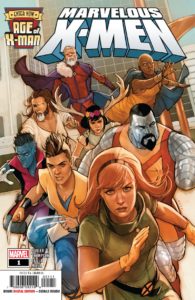 Marvelous X-Men #1 (of 5) — Writers: Zac Thompson and Lonnie Nadler; Art: Marco Failla; Colors: Matt Milla
Marvelous X-Men #1 (of 5) — Writers: Zac Thompson and Lonnie Nadler; Art: Marco Failla; Colors: Matt Milla
Uncanny X-Men #11 (Legacy #630) — Writer: Matthew Rosenberg; Art: Salvador Larroca, John McCrea and Juanan Ramirez
The Immortal Hulk #13 (Legacy #730) — Writer: Al Ewing; Pencils: Joe Bennett; Inks: Ruy Jose with Belardino Brabo and Rafael Fonteriz
Avengers #14 (Legacy #704) — Writer: Jason Aaron; Art: 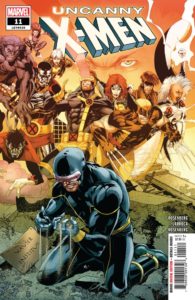 David Marquez; Colors: Justin Ponsor and Erick Arciniega
David Marquez; Colors: Justin Ponsor and Erick Arciniega
Tony Stark: Iron Man #8 (Legacy #608) — Writer: Dan Slott; Art: Valerio Schiti; Colors: Edgar Delgado
Marvelous X-Men is the first of the five-issue Age of X-Man-related titles out between now and summer; it sets up the world created by Nate Gray at the end of Uncanny X-Men #10 as a wish-fulfillment society where everyone‘s a mutant, and the X-Men are loved and respected — but, of 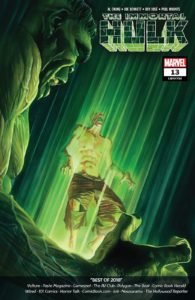 course, there are dystopian flies in the ointment, including a ban on physical relationships and a rebel group led by Apocalypse and Kitty Pryde, who were shielded from the effects of the change. Meanwhile, in Uncanny X-Men #11, also out this week, back in the “real” Marvel world the X-Men have simply vanished, leaving the mutant-haters to try to take over and eliminate that minority completely; enter a reborn Cyclops, who’s eventually joined by an also-reborn Original Wolverine as those two frenemies take on pretty much everybody. Matthew Rosenberg offers three stories in this giant-sized issue, telling the same events
course, there are dystopian flies in the ointment, including a ban on physical relationships and a rebel group led by Apocalypse and Kitty Pryde, who were shielded from the effects of the change. Meanwhile, in Uncanny X-Men #11, also out this week, back in the “real” Marvel world the X-Men have simply vanished, leaving the mutant-haters to try to take over and eliminate that minority completely; enter a reborn Cyclops, who’s eventually joined by an also-reborn Original Wolverine as those two frenemies take on pretty much everybody. Matthew Rosenberg offers three stories in this giant-sized issue, telling the same events  from the perspectives of Cyclops, Wolverine (whose chapter is drawn by longtime Garth Ennis collaborator John McCrea), and the young prophet/psychic Blindfold; that turns out to be an effective narrative device, with each story intersecting the others, and the whole Last Heroes Standing bit is an easy, dramatic sell. Speaking of easy sells, Immortal Hulk ends its second arc with a battle against Hell on Earth, a narration covering Kabbalistic mythology in more detail than anyone this side of Alan Moore, a number of guest appearances and a last-page title reveal that’s, I believe, from the Joan Baez song “Diamonds and Rust”; if those aren’t enough reasons to read it, look at the cover’s list of 14 media sites/critics who voted this book
from the perspectives of Cyclops, Wolverine (whose chapter is drawn by longtime Garth Ennis collaborator John McCrea), and the young prophet/psychic Blindfold; that turns out to be an effective narrative device, with each story intersecting the others, and the whole Last Heroes Standing bit is an easy, dramatic sell. Speaking of easy sells, Immortal Hulk ends its second arc with a battle against Hell on Earth, a narration covering Kabbalistic mythology in more detail than anyone this side of Alan Moore, a number of guest appearances and a last-page title reveal that’s, I believe, from the Joan Baez song “Diamonds and Rust”; if those aren’t enough reasons to read it, look at the cover’s list of 14 media sites/critics who voted this book  as one of the best of 2018: me, too. Avengers spotlights a “vampire civil war” plot that’s been bubbling under the surface the last few issues, and capitalizes on how that causes conflicts between Ghost Rider’s human and demonic halves. I like the color palette, muted for the shadowy supernatural parts and then flaring to vivid life in the dramatic sequences: an example of the entire creative team’s attention to detail. Iron Man has some of that, too, in the middle of a big Controller-using-online-gamers arc combining virtual reality (complete with virtual drinking), brainwashing, betrayal, relationship drama, and a fair amount of punching — more than enough to keep readers interested.
as one of the best of 2018: me, too. Avengers spotlights a “vampire civil war” plot that’s been bubbling under the surface the last few issues, and capitalizes on how that causes conflicts between Ghost Rider’s human and demonic halves. I like the color palette, muted for the shadowy supernatural parts and then flaring to vivid life in the dramatic sequences: an example of the entire creative team’s attention to detail. Iron Man has some of that, too, in the middle of a big Controller-using-online-gamers arc combining virtual reality (complete with virtual drinking), brainwashing, betrayal, relationship drama, and a fair amount of punching — more than enough to keep readers interested.
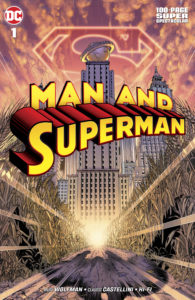 Man and Superman #1 (of 1) — Writer: Marv Wolfman; Art: Claudio Castellini; Colors: Hi-Fi
Man and Superman #1 (of 1) — Writer: Marv Wolfman; Art: Claudio Castellini; Colors: Hi-Fi
Green Lantern #4 — Writer: Grant Morrison; Art: Liam Sharp; Colors: Steve Oliff
Batman #64 — Writer: Joshua Williamson; Art: Guillem March; Colors: Tomeu Moray
Justice League #17 — Writer: Scott Snyder; Pencils: Jim Cheung; Inks: Cheung with Walden Wong and Mark Morales; Colors: Tomeu Moray
Young Justice #2 — Writer: Brian Michael Bendis; Art:  Patrick Gleason and Emanuela Lupacchino with Ray McCarthy; Colors: Alejandro Sanchez
Patrick Gleason and Emanuela Lupacchino with Ray McCarthy; Colors: Alejandro Sanchez
United States Vs. Murder Inc. #6 — Writer: Brian Michael Bendis; Art: Michael Avon Oeming; Colors: Taki Soma
Man and Superman is a young-Clark-Kent-comes-to-Metropolis origin story; as a two-page essay by writer Marv Wolfman explains, it was originally meant to be a four-issue mini-series, but because it was finished right before the new-52 relaunches in the early ’10s, and didn’t fit into continuity, it’s been sitting around looking for a publishing format since then — and now, finally, here it is, in a 100-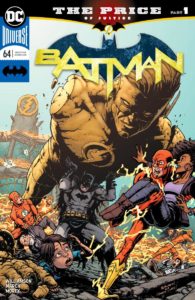 pages-with-no-ads one-shot for $9.99. That history makes it sound like a dog, but it’s not — Wolfman calls it the best Superman story he’s ever written, and that says a lot coming from someone with his long history with DC; the art, by Claudio Castellini, is of the DC-realistic Neal Adams/Jose Luiz Garcia-Lopez school, and looks great. It’s a smoothly-paced coming-of-age tale with no wasted space and keen insight into the characters of both Kent and his supporting cast, and if you’re any kind of Superman fan, you’ll like it a lot, and consider it a bargain. Green Lantern continues its relaunch under Grant Morrison; he’s having a lot of fun doing interstellar space coops, with imaginative aliens, cosmic-level menaces, and a Hal Jordan who’s more Clint
pages-with-no-ads one-shot for $9.99. That history makes it sound like a dog, but it’s not — Wolfman calls it the best Superman story he’s ever written, and that says a lot coming from someone with his long history with DC; the art, by Claudio Castellini, is of the DC-realistic Neal Adams/Jose Luiz Garcia-Lopez school, and looks great. It’s a smoothly-paced coming-of-age tale with no wasted space and keen insight into the characters of both Kent and his supporting cast, and if you’re any kind of Superman fan, you’ll like it a lot, and consider it a bargain. Green Lantern continues its relaunch under Grant Morrison; he’s having a lot of fun doing interstellar space coops, with imaginative aliens, cosmic-level menaces, and a Hal Jordan who’s more Clint 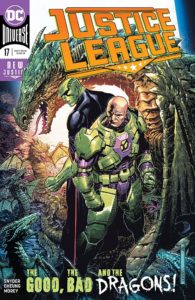 Eastwood/Dirty Harry than Superman (last issue, he “killed” a bad guy, although the resolution of that seems super-obvious…); it’s a fast-moving, ultra-imaginative ride, and one well worth taking. Batman takes a break from its Tom King saga to let Flash writer Joshua Williamson pen a four-part murder-mystery crossover between the Dark Knight and Scarlet Speedster’s comics. DC thinks it’s good, considering they’ve been using double-page centerfold ads to promote it in all their books for the last month, and in fact its first part offers Williamson’s typical spot-on characterization, some setup and a suitably-twisty plot that ends on a cliffhanger reveal with ties to the very early issues of Batman’s current volume: everything needed to satisfy fans of both books, and get them to read it. Justice League
Eastwood/Dirty Harry than Superman (last issue, he “killed” a bad guy, although the resolution of that seems super-obvious…); it’s a fast-moving, ultra-imaginative ride, and one well worth taking. Batman takes a break from its Tom King saga to let Flash writer Joshua Williamson pen a four-part murder-mystery crossover between the Dark Knight and Scarlet Speedster’s comics. DC thinks it’s good, considering they’ve been using double-page centerfold ads to promote it in all their books for the last month, and in fact its first part offers Williamson’s typical spot-on characterization, some setup and a suitably-twisty plot that ends on a cliffhanger reveal with ties to the very early issues of Batman’s current volume: everything needed to satisfy fans of both books, and get them to read it. Justice League 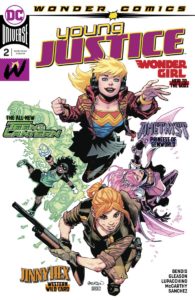 teams Lex Luthor and the Martian Manhunter, with a retcon about how they actually met when both were kids (one that Lex was mind-wiped not to remember); continuity implants like that can be tricky, but it works OK here, adding a dimension to both characters. This Scott Snyder version of the JL has been piling on cosmic/multiversal-level threats and changes since its first issue, though, and it’s all blurring together; at some point he needs to resolve them and slow down to give readers a break — and a breath. That leaves two Brian Bendis books (I think DC’s contracturally obligated to publish at least two Bendis books every week…?), with Young Justice mixing old and new team members in a plot involving
teams Lex Luthor and the Martian Manhunter, with a retcon about how they actually met when both were kids (one that Lex was mind-wiped not to remember); continuity implants like that can be tricky, but it works OK here, adding a dimension to both characters. This Scott Snyder version of the JL has been piling on cosmic/multiversal-level threats and changes since its first issue, though, and it’s all blurring together; at some point he needs to resolve them and slow down to give readers a break — and a breath. That leaves two Brian Bendis books (I think DC’s contracturally obligated to publish at least two Bendis books every week…?), with Young Justice mixing old and new team members in a plot involving 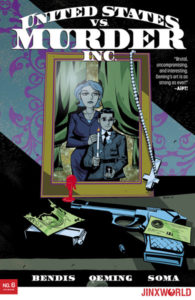 Amethyst and Gemworld; if you grew up on ’80s and ’90s DC stuff — like Bendis did — this is a valentine to that era, and written in a breezy, action-filled style that reminds me of Peter David’s on this comic’s original run. The other Bendis contribution, United States Vs. Murder Inc., is a gonzo alternate-history tale about the Mafia taking over part of the US in the ’60s, and now involved in a blood-soaked revenge match with the federal government. Lots of eye-popping stuff has happened in this series, which ends its second volume with this issue, and judging by the title of the next one — The United States of Murder, Inc. Vs. the Vatican — it’s not going to slow down any time soon.
Amethyst and Gemworld; if you grew up on ’80s and ’90s DC stuff — like Bendis did — this is a valentine to that era, and written in a breezy, action-filled style that reminds me of Peter David’s on this comic’s original run. The other Bendis contribution, United States Vs. Murder Inc., is a gonzo alternate-history tale about the Mafia taking over part of the US in the ’60s, and now involved in a blood-soaked revenge match with the federal government. Lots of eye-popping stuff has happened in this series, which ends its second volume with this issue, and judging by the title of the next one — The United States of Murder, Inc. Vs. the Vatican — it’s not going to slow down any time soon.
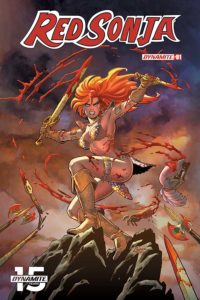 Red Sonya #1 — Writer: Mark Russell; Art: Mirko Colak; Colors: Dearbhla Kelly
Red Sonya #1 — Writer: Mark Russell; Art: Mirko Colak; Colors: Dearbhla Kelly
Archie: 1941 #5 (of 5) — Writers: Brian Augustyn and Mark Waid; Art: Peter Krause; Colors: Kelly Fitzpatrick
Archie #702 — Writer: Nick Spencer; Art: Marguerite Sauvage and Sandy Jarrell; Colors: Matt Herms
Die #3 — Writer: Kieron Gillen; Art/Colors: Stephanie Hans
 B.P.R.D.: The Devil You Know #13 — Writers: Mike Mignola and Scott Allie; Art: Lawrence Campbell; Colors: Dave Stewart
B.P.R.D.: The Devil You Know #13 — Writers: Mike Mignola and Scott Allie; Art: Lawrence Campbell; Colors: Dave Stewart
The Umbrella Academy: Hotel Oblivion #5 (of 7) — Writer: Gerard Way; Art: Gabriel Ba; Colors: Nick Filardi
Cemetery Beach #6 (of 7) — Writer: Warren Ellis; Art/Colors: Jason Howard
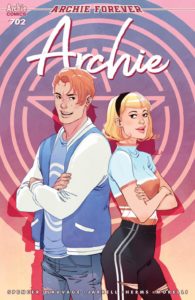 Red Sonya begins yet another year with yet another first issue; this volume is written by Mark Russell (The Flintstones, The Jetsons, Snagglepuss), who, as he did with those previous titles, contributes (a) some clever, if anachronistic, sociopolitical commentary and dialogue, and (b) little connection between the characters in his version and any previous ones. That actually works better for Sonya than the Hanna-Barbara properties, because, other than “She-Devil with a sword,” she doesn’t have much established
Red Sonya begins yet another year with yet another first issue; this volume is written by Mark Russell (The Flintstones, The Jetsons, Snagglepuss), who, as he did with those previous titles, contributes (a) some clever, if anachronistic, sociopolitical commentary and dialogue, and (b) little connection between the characters in his version and any previous ones. That actually works better for Sonya than the Hanna-Barbara properties, because, other than “She-Devil with a sword,” she doesn’t have much established 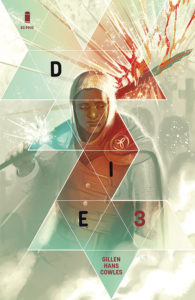 character, at least in the original Robert A. Howard version, and it turns out to be an interesting plot, involving a very powerful, spoiled and amoral dictator — the kind of thing that, say, Jason Aaron might write, and enough to pique my interest. Archie: 1941 concludes its “Riverdale during WWII” mini-series with the town mourning an Archie killed in the North African theater — but it turns out better than you might expect, and its meditation on the sacrifices and turmoil brought on by that war have given it some heft. Archie
character, at least in the original Robert A. Howard version, and it turns out to be an interesting plot, involving a very powerful, spoiled and amoral dictator — the kind of thing that, say, Jason Aaron might write, and enough to pique my interest. Archie: 1941 concludes its “Riverdale during WWII” mini-series with the town mourning an Archie killed in the North African theater — but it turns out better than you might expect, and its meditation on the sacrifices and turmoil brought on by that war have given it some heft. Archie  itself sees the redhead secretly dating Sabrina, and everyone else trying to figure out what’s going on with him; this is probably the closest version of the comic yet to the TV show — although the characters here retain more of their small-town morality and charm — and since that show’s been so successful, it’s hard to argue with the direction. Die, Kieron Gillen’s latest, continues its Jumanji/D&D mashup, with this third issue deepening the character relationships and backgrounds, and its magical dimension’s underpinnings and setup: that kind of careful, thoughtful world-building
itself sees the redhead secretly dating Sabrina, and everyone else trying to figure out what’s going on with him; this is probably the closest version of the comic yet to the TV show — although the characters here retain more of their small-town morality and charm — and since that show’s been so successful, it’s hard to argue with the direction. Die, Kieron Gillen’s latest, continues its Jumanji/D&D mashup, with this third issue deepening the character relationships and backgrounds, and its magical dimension’s underpinnings and setup: that kind of careful, thoughtful world-building 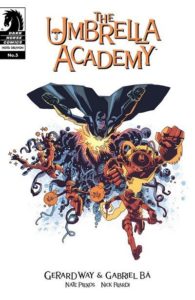 and surprising plot developments are typical of him (see: The Wicked and the Divine, especially) and serve him well here, too. The characters in B.P.R.D. have been around for decades now, and in this issue enter their final battle together; with only two issues to go after this one, expect apocalyptic events, and no guarantee who, if anyone, will get out alive; watching Mike Mignola help bring this to a close, with the covers by him and Hellboy back in the cast, feels like the inevitable end of a long, adventure-filled journey, with all the bittersweetness that implies. I continue to have no idea what’s going on in The Umbrella Academy: Hotel
and surprising plot developments are typical of him (see: The Wicked and the Divine, especially) and serve him well here, too. The characters in B.P.R.D. have been around for decades now, and in this issue enter their final battle together; with only two issues to go after this one, expect apocalyptic events, and no guarantee who, if anyone, will get out alive; watching Mike Mignola help bring this to a close, with the covers by him and Hellboy back in the cast, feels like the inevitable end of a long, adventure-filled journey, with all the bittersweetness that implies. I continue to have no idea what’s going on in The Umbrella Academy: Hotel  Oblivion, even though it, too, has only two more issues after this one; as always, though, it doesn’t matter, because Gabriel Ba’s art is totally worth viewing, especially with all the weird stuff Gerard Way gives him to draw. Some of that applies to Cemetery Beach, too — Jason Howard can draw almost anything and make it look good, and the Warren Ellis plot here, although he’s used it before — two social outcasts meeting, bonding and fighting through a bunch of bad guys — lets him cover pyrotechnic explosions, cobbled-together military hardware, science-fictional elements and snarky pseudo-romance and make them all look good.
Oblivion, even though it, too, has only two more issues after this one; as always, though, it doesn’t matter, because Gabriel Ba’s art is totally worth viewing, especially with all the weird stuff Gerard Way gives him to draw. Some of that applies to Cemetery Beach, too — Jason Howard can draw almost anything and make it look good, and the Warren Ellis plot here, although he’s used it before — two social outcasts meeting, bonding and fighting through a bunch of bad guys — lets him cover pyrotechnic explosions, cobbled-together military hardware, science-fictional elements and snarky pseudo-romance and make them all look good.



